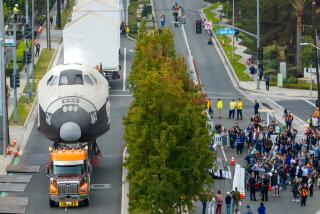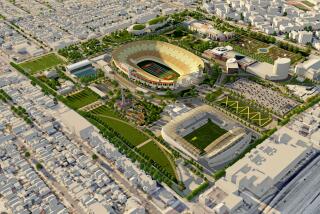Spacecraft, Airplanes in Exposition Park
- Share via
During the planning stages prior to the construction of the Aerospace Museum in Exposition Park, a panel of experts representing museum curators, exhibit designers, the aerospace industry, and the museum’s science curator, Dr. Eugene Harrison, met frequently to discuss how best to create a center where the public could learn visually about flight and the universe.
The concept they adopted was not to fill the building with hardware, but to create a setting where people could walk through the entrance into virtually another realm to discover the universe and the wonders of outer space.
The success of their combined expertise can be measured by attendance figures since the museum opened in July, 1984. Last year there were nearly 5 million visitors, the second largest attendance at an aerospace museum in the United States, surpassed only by the Smithsonian’s National Air and Space Museum in Washington. The museum’s display of flying machines of the past and present, including space vehicles, ranks second in scope only to the Smithsonian’s comprehensive collection.
Simulated Runway
On the outside of the building, a Douglas DC-8 is parked on a simulated runway, its nose pointed toward the intersection of Exposition Boulevard and Figueroa Street. A truck stands by waiting to refuel the aircraft, which was christened City of Los Angeles and delivered to United Air Lines in 1966. It was retired in 1984 after carrying more than 1 million passengers. Adjacent is a DC-3, once an executive jet for Union Oil. A Lockheed F-104 Starfighter soaring skyward is mounted on a roof pedestal on the south side of the building. It is an appropriate guidepost for the related exhibits you will discover inside.
Within the building is a display of aircraft, suspended from a 70-foot ceiling, which traces the history of flight from the Wright Brothers’ 1902 glider--before a motor was installed--to the space shuttle. A shiny red P-51 Mustang of World War II vintage appears to be flying as wingman to an Air Force T-38 Trainer. The most fascinating of all is the Gemini 11 re-entry module in which Navy Comdr. Charles (Pete) Conrad Jr. and Lt. Comdr. Richard Francis Gordon Jr. made a historic journey in a U.S. spaceship in September of 1966. It is on loan from the Smithsonian Institution.
One pauses to study this vehicle and, if old enough, recall the excitement at the time of their spectacular achievement. The two astronauts had flown their spaceship to a record altitude of 849.85 miles. On Sept. 15, Conrad and Gordon returned from their mission after 44 revolutions around the earth, splashing down into the Atlantic at 10 a.m. They had been in space for 71 hours and 17 minutes.
Also suspended from the ceiling like giant Christmas-tree ornaments are full-scale models of weather and communications satellites, one a device to search for life on Mars. By using several balconies within the building, visitors can obtain an eye-level view of the aircraft and satellites.
The Aerospace Museum is part of its neighboring Museum of Science and Industry, from which it adopted its user-friendly design of visitor-operated exhibits: You push buttons, pull levers and touch computer keyboards to activate them. You can tap into a national weather satellite and learn the weather in any city, or call up satellite images of the entire Western Hemisphere or the continental United States, which will give you weather patterns as they occurred at two hour intervals for the past 16 hours. Visitors can test their navigational skills with a mechanical gyroscope.
Big-Screen Film
One of the highlights of any visit is to pause in the museum’s theater to watch a 13-minute film, “The Windows of the Universe.” This is shown on a giant composite of nine screens using 21 projectors. It depicts the birth of the universe and man’s exploration of the solar system. Color photos light up to present the story that was written by science-fiction writer Ray Bradbury and narrated by actor James Whitmore. The presentation lifts off with views of Los Angeles and then soars to the far reaches of space.
While operated by the state, the museum is a joint undertaking of a number of corporations and private individuals who contribute financial support. It also serves as a showcase for the California aviation and aerospace industry.
The Aerospace Museum is located on Exposition Boulevard just west of Figueroa Street. Nearby parking is available. It is open seven days a week from 10 a.m. to 5 p.m. Admission is free.
planes, 1 or 2 lines, 38p6
More to Read
The biggest entertainment stories
Get our big stories about Hollywood, film, television, music, arts, culture and more right in your inbox as soon as they publish.
You may occasionally receive promotional content from the Los Angeles Times.










